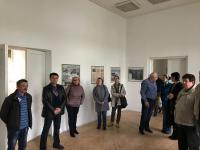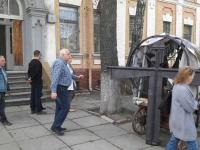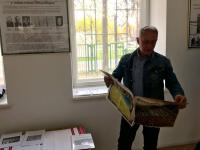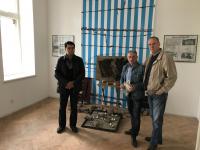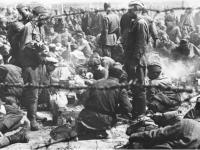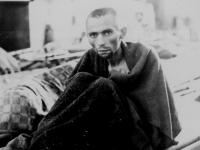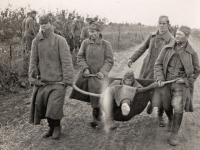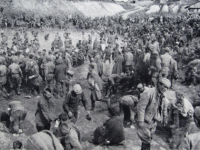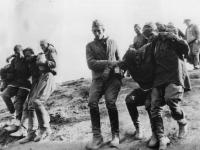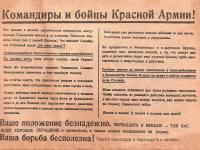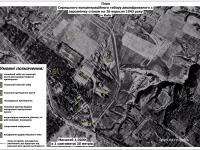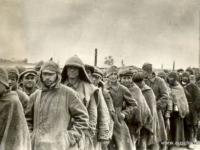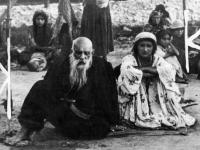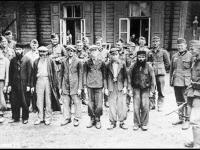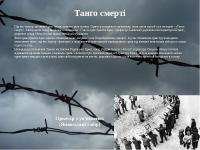April 11 to the International Day for the Liberation of Prisoners of Nazi сoncentration сamps opened an exhibition "Moloch of War - Nazi Concentration Camps" In the exhibition hall of the National Historic-Memorial Reserve "Babyn Yar" (Kyiv, Melnikova Str.,44). In 1933, Nazis came to power in Germany. They immediately began to establish a system of isolation and destruction of their political opponents, unreliable and "harmful" groups of the population. At the order of the head of police in Munich, the future Reichsführer SS Henry Himmler, the first concentration camp in Nazi Germany was formed on March 22, 1933, in Dachau. Subsequently, there were other concentration camps - Sachsenhausen (1936), Papenburg (1936), Buchenwald (1937), Mauthausen (1938), Flossenburg (1938), Neuengamme (1938), and аlso, the women's concentration camp Ravensbruck (1938). In Germany, there were about 400 concentration camps without numerous subsidiaries. The largest ones were Mauthausen, Buchenwald, Dachau. In Ukraine, classical samples of concentration camps were Yanivsky (in Lviv) and Syretsky (near Kiev).
According to the archival institutions of the Federal Republic of Germany, published in 1965, there were 1,634 camps and their external teams (branches) in the territory of the Third Reich and the occupied territories. For Nazis, the Ukrainian nationalists were the particularly dangerous category of prisoners. Most of them were imprisoned at concentration camps Auschwitz, Sachsenhausen, Buchenwald, Ebensee. The frantic persecution the OUN members began after the proclamation of the Act of Recovery of the Ukrainian State of June 30, 1941. Since September 15, 1941, members of the OUN were massively arrested in Lviv, Drohobych, Sambir, Stryi, Stanislav and other cities of Western Ukraine. One of the first was arrested Stepan Bandera - the head of the OUN-B. On January 24, 1942, the leading members of the OUN were removed to the Sachsenhausen concentration camp. The concentration camp Ravensbrück was founded in 1938 exclusively for women. This concentration camp received the nickname "L'Enfer des Femme" ("Women's Hell"). Ukrainian women and girls, students and graduates from the Western Europe's universities, members of the Ukrainian underground got into Ravensbruck. After a six-month stay in the Prison at Łąckiego in Lviv, the first head of the OUN Security Service (1941-1942) Mykola Lebyd's wife Darya Gnatkivska-Lebyd got into Ravensbryuk also. In 1945, 46,000 female prisoners were staying here who have been collected from all over Europe. Officially, according to the documents of the administration, 2,503 Ukrainian women were registered at the concentration camp. They were underground members from Kolomyia, Lviv and other cities of Western Ukraine. From the memories of former prisoners, there were much more Ukrainian women - from 3 to 7 thousand. Forced labour of concentration camp prisoners had been widely used by well-known German enterprises such as IG Farbenindustrie, Siemens, German Gering Verke, IGMetal, Volkswagen, Hoechst AG, BMW and others. Concentration camp "Uman Pit". In summer of 1941, the Nazis set up a concentration camp in the western part of Uman. It was one of the first in the former USSR. At that place, before the war, there was a turkey farm, and later a clay quarry. Its depth reached 7 meters, the width was 300 meters, and the length - about 1 km.
The Germans brought the Soviet prisoners of war there and kept them in the open air. That's why the people called this territory the Uman pit. The first prisoners of war are the men of the 6th and 12th Soviet Armys. According to the German command, on August 14, 1941, about 50 thousand Soviet soldiers were imprisoned in the Uman pit. On the outskirts of the city, in Sukhoi Yar, more than 13,000 Umani Jews were shot. A few thousand Umantas were taken to forced labor in Germany. Later, the concentration camp led people from everywhere. The prison conditions of the Uman pit were terrible. The first days people were not fed at all, there was no water. The prisoners drank all the puddles. They began to eat clay. Every morning, the Nazis threw bodies of dead prisoners on the edge of the pit and trained in firing them with machine guns and pistols. Darnytsky concentration camp (in German sources - Kyiv-East, German Kiew-Ost (since September 1941), Stalag 339 Kiev-Darnitsa, d. Stalag 339 Kiew-Darniza (since January 1942) - concentration camp, created by German occupation power in the Darnytsia forest of Kiev during the Second World War (1941-1943), was intended for the prisoners of war of the Red Army, 300 thousand people passed through the camp, 68 thousand of them died in it. The Syrets concentration camp was one of the concentration camps that were created by the Nazis in Kyiv during the occupation of the city in 1941-1943. It was destined for prisoners under the decision of the Gestapo, subjecting the inspection of the Third Reich concentration camps. It was located in the historical area of Syrets, approximately within the boundaries of the modern streets of T. Shamryla, Riga’s, Academician Grekov, Shchusev street in the place of territory, used for summer military camps. According to German sources, from July 1942 until the spring of 1943 he functioned as an outside command of the concentration camp Zahsenghausen, known as "Kiev-West" ("Kiev-West"). The Extraordinary State Commission had determined the number of deaths in the camp - 25 thousand people. Yaniv concentration camp - concentration camp and death camp, organized by the Nazis in September 1941 on the outskirts of the city of Lviv. The German name Janowska was due to the fact that he was on Yanovskaya Street 134 (now Shevchenko Street). Acted until June 1944. There were destroyed 140 to 200 thousand Jews, Poles, Ukrainians. During torture, torture and shootings, music has always been played. The orchestra consisted of prisoners, they played the same melody - "Tango of Death". Among the orchestra students were Professor of the Lviv State Conservatory Strix, conductor of the opera Mund and other well-known Jewish musicians. During the hangings, the orchestra was ordered to perform tango, during the torture - foxtrot, and sometimes in the evening, orchestras were forced to play under the windows of the camp chief for several hours in a row. On the eve of the liberation of Lviv by the Soviet Army, the Germans built a circle of 40 people from the orchestra. The camp guard surrounded the musicians with a dense ring and ordered the play. At first, the conductor of the Mund Orchestra was executed, then on command of the commandant, each orchestra went out to the center of the circle, put his instrument on the ground, undressed naked before being shot with a head.
The photo of orchestras was one of the indictments in the Nuremberg trial. Buchenwald is a concentration camp near Weimar (Germany). Began to function on July 19, 1937, as a camp for criminals, but soon they began to send there political prisoners. In June 1938, the first group of prisoners arrived in Buchenwald, which consisted entirely of Jews. In summer 1938, 2200 Austrian Jews from Dachau were transferred to Buchenwald. In 1938, after the "Crystal Night", the number of Jews in prison more than doubled. By the spring of 1939, most Jews were released, but they were deprived of their property and forced to leave Germany. Since the beginning of the Second World War, the influx of prisoners has increased. Soviet prisoners of war, as a rule, were destroyed immediately upon arrival. Since the beginning of 1942 in Buchenwald, there were created enterprises that produced military products. On October 17, 1942, all Jews, with the exception of 200 masons, were transferred from Buchenwald to Auschwitz. On October 6, 1944, the number of prisoners reached the maximum limits (89,143). From the end of 1944, leaving the occupied territories east of Germany, the Germans began to evacuate camps located there, and thousands of prisoners, including many Jews, were transferred to Buchenwald, where they massacred. In early April 1945, SS soldiers took out several thousand Jews from the camp. However, the mass evacuation, scheduled for April 5, 1945, did not succeed. Of the 238,380 prisoners who have gone through Buchenwald since its inception, 56,549 have died or have been killed. A lot of medical experiments were carried out over the prisoners, as a result of which most died of painful death. Prisoners were infected with typhus, tuberculosis and other dangerous diseases in order to test the effect of vaccines against pathogens of these diseases. The disease has developed very quickly in the epidemic due to crowding in the barracks, lack of hygiene, poor nutrition, and also because these diseases were not treated. In total, about a quarter of a million prisoners from across the European countries passed through the camp. The number of victims was about 56,000, including 11,000 Jews. The past pages should never be forgotten. The "generation of war" passed difficult way. The main thing is that it does not happen again. "That does not happen again" - echoes in our hearts.




















